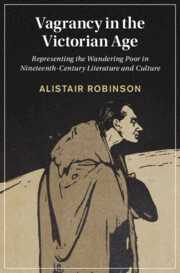 Vagrancy in the Victorian Age
Vagrancy in the Victorian Age Book contents
- Vagrancy in the Victorian Age
- Cambridge Studies in Nineteenth-Century Literature and Culture
- Vagrancy in the Victorian Age
- Copyright page
- Dedication
- Contents
- List of Illustrations
- Acknowledgements
- Introduction
- Part I The Country
- Chapter 1 Gypsies, Hawkers and Handicraft Tramps
- Chapter 2 Poachers
- Part II The City
- Part III The Frontier
- Afterword: London 1902
- Bibliography
- Index
- Cambridge Studies in Nineteenth-Century Literature and Culture
Chapter 1 - Gypsies, Hawkers and Handicraft Tramps
from Part I - The Country
Published online by Cambridge University Press: 02 November 2021
- Vagrancy in the Victorian Age
- Cambridge Studies in Nineteenth-Century Literature and Culture
- Vagrancy in the Victorian Age
- Copyright page
- Dedication
- Contents
- List of Illustrations
- Acknowledgements
- Introduction
- Part I The Country
- Chapter 1 Gypsies, Hawkers and Handicraft Tramps
- Chapter 2 Poachers
- Part II The City
- Part III The Frontier
- Afterword: London 1902
- Bibliography
- Index
- Cambridge Studies in Nineteenth-Century Literature and Culture
Summary
The Gypsy is one of the most prominent vagrant figures in nineteenth-century literature and culture, and has received a considerable amount of critical attention. This chapter situates the Gypsy alongside other rural itinerants, such as hawkers and handicraft tramps, in order to address how racial and aesthetic assumptions conditioned the representation of Gypsies in British print culture. Focusing on the period 1830–60, this chapter first examines how a legacy of picturesque representation combined with more recent theories of extinction, and how these were combined in periodical articles that depicted the Gypsies as a ‘vanishing race’. This is followed by an in-depth analysis of George Borrow’s autobiography Lavengro (1851) and its sequel The Romany Rye (1857). Here I argue that while Borrow reiterated racial interpretations of English Gypsies, he actively critiqued the picturesque tradition that sought to idealise them and other rural itinerants in Britain. Alongside Borrow, this chapter examines works by George Eliot and Mary Russell Mitford.
Keywords
- Type
- Chapter
- Information
- Vagrancy in the Victorian AgeRepresenting the Wandering Poor in Nineteenth-Century Literature and Culture, pp. 27 - 57Publisher: Cambridge University PressPrint publication year: 2021


